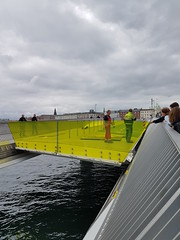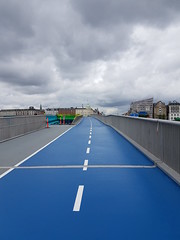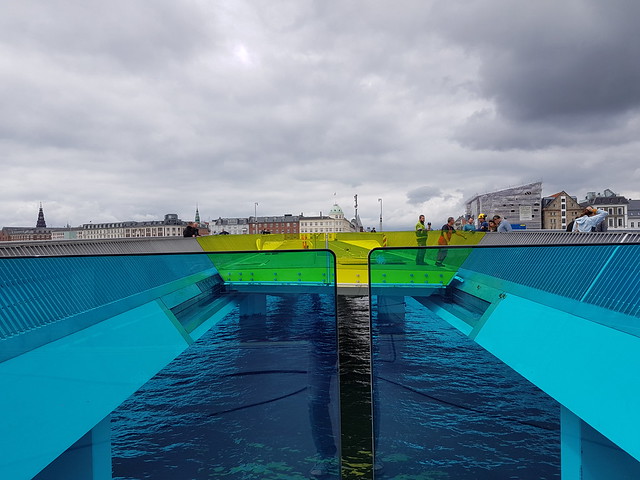
By Mark Werner / Copenhagenize Design Company
Copenhagen’s Inderhavnsbroen (Inner Harbor Bridge) has been a seemingly never ending story of mishaps and constant delays. This bridge has endured problems ranging from incorrect designs to contractor bankruptcies, all of which have led to pushbacks of the process day-by-day, month-by-month. From an effort by the city to connect all parts of the harbor for tourists and allowing eager citizens to shave minutes off their commutes, has led to a massive headache and a chorus of groans and eye-rolls by citizens and traveler alike. Locally known as the “kissing bridge” through these constant delays it has subsequently earned its name as the “missing bridge”.
Inderhavnsbroen is an entirely new design for a bridge or, in other words, overcomplicated beyond belief. It was intended to be a radical distinguished design unique to Copenhagen, beyond the average drawbridges that have worked for more than a thousand years across water everywhere.
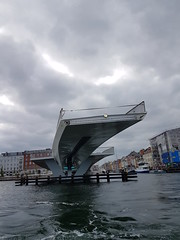
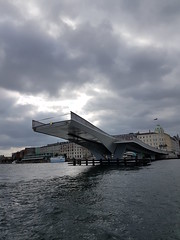
Inderhavnsbroen consists of two moving platforms that meet in the center, and like a puzzle piece metal points one side of the bridge slides and locks into the other side. These two platforms slide outward into the immobile segments of the bridge, leaving a gap in the center letting boats through. It's a bit too much like Magpie Architecture to us.
Inderhavnsbroen is part of Copenhagen’s much larger plan, known as the Harbor Circle project, to ease commuting and increase connectivity of many notable points around the harbor for visitors and locals.
This bridge would link the highly visited Nyhavn, and the business heavy area of Kongens Nytorv, to the highly populated Christianshavn onto the island Amager. With roughly 3-7,000 cyclists expected daily, significant congestion would be relieved from the closest and traffic-heavy Knippelsbro (bridge) with over 40,000 cyclists a day.
Construction for Inderhavnsbroen began in 2011 and was set for completion in early 2013...not the case, as it stands incomplete today and no formal opening in sight. It has become one of Copenhagen’s most notable points, but for all the wrong reasons.
[1] The sequence of problems began as early as 2012 when two of the main support beams arrived 60cm too tall! This was due to poor drawings in the plan. It’s bad enough for engineers to make a mistake of a few millimeters, not 60 cm! An extra 4 months were added to the project as time was taken to pat down the beams until they were at the appropriate height.
[2] Problems continue into May of 2013, when the two steel moving platforms arrive from a Spanish company show serious flaws. Despite these defects, contractual agreements require the project to continue, still using the same 250-ton beams.
[3] By April of that year the tragedies continue when cracks are found on the surface and need to be reinforced.
[4] As the summer continues weaknesses are found in the infrastructure and parts of the concrete bow down underneath the bridge; time is taken to apply necessary reinforcements. By August Pihl and Søn, the main contractors of the project declare their bankruptcy and all work stops on the bridge for 9 months, until the city of Copenhagen takes over the project. This is the point where it begins to sound like a cruel joke, Pihl and Søn is an international contracting group in business for over 100 years, and it is during this already endless project that they go out of business.
[5] By December a storm hits Copenhagen, and due to improper storage a machine room below the bridge floods and two motors become damaged beyond repair. All the while, as delays are added the costs only rise on this project.
[6] As spring begins in 2014 fears grow that even more reinforcements are needed! Many tests are done, and it turns out the be a false alarm, however, the delays still pile up. Work continues, and a new polish contracting group takes over the project. No drastic delays occur on the bridge until August of 2015
[7], when one of the draw-wire systems that pulls the movable platform back has snapped...delays carry on. The most recent problem encountered was discovered in November of 2015
[8], when one boogie-system, the set of wheels that roll the moving platforms back and forth, was discovered to be too weak. A whole new system needed to be designed, created, and installed, which was finished in April 2016. A whole set of new problems however is exacerbated by the initial plans
[9], in May of 2016 it was discovered that the change of warm air combined with the still-cold harbor water was causing the bridge to bend and skew. The fact that the bridge may squirm was taken into the design, however, not when the temperature change is so drastic between warm air to cold water... which is strange because that is basically every spring in Copenhagen for countless millenia.

All these delays have come at a huge cost, which sets in place the next set of problems, who is going to pay? It’s now highly debated between Copenhagen and Pihl and Søn contractors, as the bridge was supposed to cost 200 million kr. but after constant delays and mishaps has now risen to 300 million kr., and the cost of Copenhagen’s share has already tripled.
With all that said, the light at the tunnel has been reached. The bridge finally opened to the public on 07 July 2016 and the official opening is scheduled for 19 August 2016.
The new boogie system has been installed and the final tests and fine tuning of the bridge are done.
Many say that Inderhavnsbroen was hit by Murphy’s Law, where anything that could go wrong has. This whole process just goes to show that sometimes you need to stick with what you know works, like the two bridges that have been in place for nearly 100 years across the harbor already. Or just ask the thousands of daily commuters in Copenhagen that longed for the day the bridge would open.
